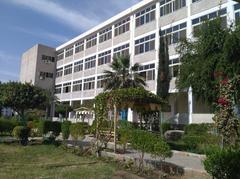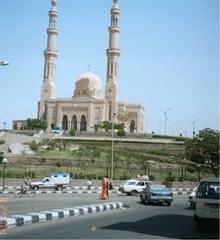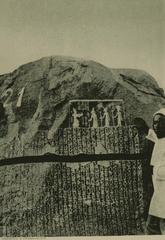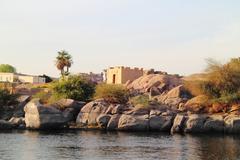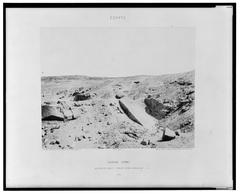International Museum of Nubia: Visiting Hours, Tickets, and Guide to Aswan Historical Sites
Date: 14/06/2025
Introduction
Set against the breathtaking backdrop of the Nile River in Aswan, Egypt, the International Nubian Museum—commonly known as the Nubian Museum—is a living tribute to one of Africa’s most enduring civilizations. This world-class institution does more than showcase thousands of artifacts from Nubia’s multi-millennial history: it stands as a monument to international cooperation, resilience, and the preservation of cultural identity in the wake of dramatic change. Whether you are a passionate historian, an archaeology enthusiast, or a curious traveler, this guide offers essential details to help you plan an enriching visit, including Nubian Museum visiting hours, ticket prices, accessibility, and tips for combining your trip with other top Aswan historical sites (UNESCO World Heritage Centre, Wikipedia, Egypt Tours Portal, Encounterstravel.com).
Historical Background: The Nubian Museum and UNESCO Recognition
Origins: International Campaign to Save Nubian Heritage
The Nubian Museum is inseparable from the great mid-20th century campaign to save Egypt’s and Sudan’s Nubian monuments from submersion under Lake Nasser, created by the construction of the Aswan High Dam. In the 1960s, UNESCO led a massive, unprecedented international effort to rescue archaeological treasures—including the temples of Abu Simbel and Philae—by relocating them to higher ground. This campaign, supported by more than 50 countries, laid the foundation for the Nubian Museum, which opened its doors in 1997 to house artifacts and tell the story of Nubia’s people and their vibrant culture (UNESCO Digital Library).
The Museum’s Mission and Impact
With over 3,000 artifacts, the Nubian Museum chronicles Nubia’s evolution through prehistoric, Pharaonic, Greco-Roman, Christian, and Islamic periods. It highlights Nubia’s role as a cultural crossroads and a corridor for trade, art, and politics between sub-Saharan Africa and the Mediterranean. The museum also documents the forced displacement of Nubian communities following the dam’s construction, ensuring their traditions and stories endure (UNESCO Digital Library).
Practical Visitor Information
Location and Getting There
- Address: El Fanadek Street, Aswan, opposite Basma Hotel
- By Air: Aswan International Airport (ASW) is about 25 minutes by taxi.
- By Train: The city is well connected to Cairo and Luxor; taxis or minibuses bring you from the train station.
- By Car: Taxis are readily available throughout Aswan.
- On Foot: Central hotels along the Nile Corniche are within walking distance (Trip.com, Encounterstravel.com).
Opening Hours
- Daily: 9:00 AM – 5:00 PM
- Extended: Open 6:00 PM – 9:00 PM on Thursdays and Fridays (check for seasonal updates and Ramadan adjustments)
- Best Time to Visit: Early morning or late afternoon to avoid crowds and midday heat (Egyptatours, Encounterstravel.com).
Tickets and Admission Fees
- Standard Adult Ticket: Approx. 60–100 EGP (subject to change)
- Discounts: Students, children, and seniors receive reduced rates; Egyptian citizens may enter free on designated days (e.g., Fridays)
- Payment: Cash preferred; some counters accept credit cards; online booking may be available (Trip.com).
Accessibility and Facilities
- Wheelchair Accessible: Ramps, elevators, and accessible restrooms throughout
- Guided Tours: Available in multiple languages for an additional fee; highly recommended for deeper insight (Encounterstravel.com)
- Café and Gift Shop: On-site, with local crafts and refreshments
- Library and Research Center: Over 10,000 volumes on Nubian history and culture
Visitor Tips
- Dress: Modest, breathable clothing is ideal for the climate.
- Photography: Allowed in most areas (no flash or tripods); always ask about restrictions.
- Hydration: Carry bottled water, especially if exploring outdoor areas.
- Language: English is widely spoken; guided tours and brochures are available in several languages.
Museum Architecture, Collections, and Exhibits
Award-Winning Architecture
Designed by Mahmoud El-Hakim and opened in 1997, the Nubian Museum echoes traditional Nubian forms—sandstone walls, domed roofs, and terraces—harmoniously blending into Aswan’s rocky landscape. It occupies a 50,000 m² site, with 7,000 m² dedicated to galleries and the rest to lush gardens and an amphitheater. Its symbolic water features and terraced design evoke the Nile’s journey from Upper to Lower Egypt, earning the Aga Khan Award for Architecture in 2001 (MoMAA, Sites International).
Collections and Chronology
- Prehistoric Era: Tools, pottery, and rock art from Nubia’s earliest inhabitants
- Pharaonic Period: Statues, jewelry, and funerary objects illustrating Nubia’s ties to ancient Egypt
- Greco-Roman and Coptic Eras: Artifacts from Nubia’s integration into the Roman world and the spread of Christianity
- Islamic and Modern Periods: Manuscripts, textiles, and items reflecting later Nubian society and the impact of the Aswan High Dam (Wikipedia, Sharm Club)
Highlights and Notable Artifacts
- Colossal Statue of Ramesses II: Centerpiece symbolizing Nubian-Egyptian fusion
- Rock-Cut Shrine of Usersatet: Reconstructed from Qasr Ibrim, rare example of Nubian temple architecture
- Mummified Ram of Khnum: With gold mask, from Elephantine Island
- Statuettes and Reliefs: Including those from Karnak and Abu Oda, showing prominent Nubian figures in ancient Egypt
- Outdoor Exhibits: Over 80 statues, a reconstructed Nubian house, and a prehistoric cave with rock art (Egyptatours, Sharm Club)
Visitor Experience
- Permanent Exhibitions: Chronologically arranged, with bilingual labels (Arabic/English)
- Ethnographic Dioramas: Life-size scenes of traditional Nubian life—farming, weddings, and daily rituals
- Special Exhibits: Documenting the international rescue of Nubian monuments and communities
- Outdoor Amphitheater: Hosts regular Nubian music, dance, and storytelling performances
- Gardens: Lush with indigenous plants, symbolic canal, and spaces for relaxation
Nearby Attractions in Aswan
Enrich your visit by exploring these renowned Aswan historical sites:
- Philae Temple Complex: Revered island temple of Isis
- Unfinished Obelisk: Ancient quarry and demonstration of obelisk carving
- Elephantine Island: Archaeological site with ancient temples and Nilometer
- Aswan Botanical Gardens: Lush, exotic gardens on Kitchener’s Island
- Nubian Villages: Experience living Nubian culture, crafts, and cuisine (Weseektravel.com)
Frequently Asked Questions (FAQ)
Q: What are the Nubian Museum’s visiting hours?
A: Open daily from 9:00 AM to 5:00 PM, with extended hours on Thursdays and Fridays.
Q: How much are tickets?
A: Standard adult tickets are 60–100 EGP; discounts available for students, children, and Egyptian citizens.
Q: Is the museum accessible for people with disabilities?
A: Yes, with ramps, elevators, and accessible restrooms.
Q: Are guided tours available?
A: Yes, in multiple languages, for an additional fee.
Q: Can I take photos inside?
A: Photography is allowed in most areas without flash or tripods; ask staff for any restrictions.
Q: What are the best nearby attractions?
A: Explore Philae Temple, Unfinished Obelisk, Elephantine Island, Botanical Gardens, and Nubian villages.
Visuals and Interactive Media
Enhance your planning and experience by reviewing:
- High-resolution images of the Nubian Museum’s architecture, gardens, and exhibits (alt tags: “Nubian Museum visiting hours,” “Nubian Museum tickets,” “Aswan historical sites”)
- Virtual tours and interactive maps on the official website
- Videos of Nubian music and cultural performances
Summary and Visitor Tips
The International Nubian Museum is not just a museum—it’s a vibrant cultural hub reflecting the depth and resilience of Nubian civilization. Its award-winning architecture and comprehensive collections make it an essential stop for understanding Egypt’s broader heritage. Combine your visit with other historical sites in Aswan and use official resources like the Audiala app for up-to-date guides, events, and curated travel tips.
Your visit supports not only the preservation of Nubian heritage but also the ongoing celebration of cultural diversity and international collaboration in Egypt’s Nile Valley (UNESCO Digital Library, MoMAA, Egyptatours, Trip.com).
Sources and Further Reading
- UNESCO World Heritage Centre
- UNESCO Digital Library
- Wikipedia: Nubian Museum
- Egypt Tours Portal
- Encounterstravel.com
- Egyptatours
- MoMAA
- Trip.com
